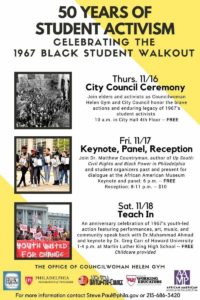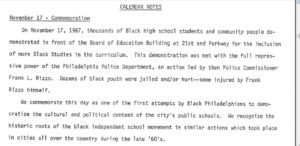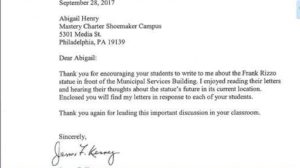On November 17, 1967, 3,500 Black students walked out of their classrooms and schools and converged at the School District of Philadelphia’s headquarters. They were on the School-to-Activism Pipeline. These student activists were protesting the dearth of Black teachers and Black studies classes. They also wanted to end disciplinary practices against students who refused to salute the flag or say the pledge of allegiance. While Colin Kaepernick is the latest to take a very public stance against national silence and indifference towards Black suffering, students have also been active and vocal leaders in these protests. What we demand today, was being demanded then (and before then).
David P. Richardson, Cecil B. Moore, and other NAACP leaders (when they actually stood for something AND did something on behalf of students) were amongst the adult activists who assisted these students.
When the student activists arrived to protest outside of the school district’s headquarters, they encountered the racist police chief, Frank Rizzo, who told police officers to “Get their Black asses!” Many school district administrators cowered inside and watched the assault on students from the windows.
An account can be found here:
By 11:00 AM, more than 3,000 protesters had assembled at the Board of Education Building. Rally organizers instructed protesters to remain peaceful and to march around the building.
Meanwhile, Superintendent Mark Shedd, who was sympathetic to the protesters, decided to meet with ten student representatives. Between ten and thirty students entered the Board of Education Building to meet with Shedd and other district officials to discuss their demands. This meeting reportedly progressed favorably for the students and Shedd was willing to negotiate. As the meeting progressed, the demonstration outside grew even larger. Reports indicate that a total of 3,500 protesters had assembled peacefully.
Expecting a large but peaceful demonstration, the Board of Education had asked the Philadelphia Police Department to refrain from sending uniformed officers to the scene. Police Commissioner Frank Rizzo arrived at the scene at noon with busloads of between 300 and 400 uniformed officers.
As the mass of protesters marched from the rear of the Board of Education building to the front, they encountered the newly arrived uniformed police officers, who were dressed in riot gear and assembled in riot formation. “They were standing like uniformed soldiers with helmets and sticks in their hands,” recalled Deborah W. Sawyer, who was a seventeen year-old junior at William Penn High School.
Participants reported that Rizzo led the charge, telling his troops to “get their Black asses.” The result was that 22 people were seriously injured and 57 were arrested.
Next week represents the 50th anniversary of the students’ bravery, leadership, and unwavering stance against racism and racist policies .

This historic event was on my elementary school’s calendar, clearly signaling what was important. Below is a copy of the page from the parent handbook (1982-83). We didn’t celebrate Columbus Day, but we did commemorate the student protest and these brave high school students’ leadership. Our teachers helped to inform our vision of leadership, activism, and heroism.

In 1992, Overbrook HS (my alma mater) students, weary of the racist mindset, words, and actions of a teacher, Mr. James, staged a walkout. As a student, I encountered Mr. James’s racist tendencies in English class. When I called him out for his racism, he proceeded to give me a D for the class. When my family complained, he said he stood by his grade. Well, a couple years later, students, including my little cousin, Hassan Shoatz, took matters in their own hands after Mr. James continued with his racist traditions. Students staged a walkout. Mr. James transferred and was eventually fired. Not soon enough though.

As parents and educators, we should carefully balance the desire to protect our children and ensure they are equipped to not only anticipate the challenges inherently saturated in racism they will face, but undermine and eradicate these oppressive systems as well. Balancing protection and exposure is delicate and will often ebb and flow based on the capacity of adults and students in the moment.
As educators, the grounding principles of equity and justice should undergird and serve as recurring themes of a holistic educational eco-system in our schools. If we are thoughtful enough, we can help provide the experiences students crave to self-actualize and empower them towards action.
Students are often eager to problem-solve and engage in the work of activism, oft-considered to be too challenging for students. Two local and relatively recent historic examples come to mind when I think of student activism.
Today, our students (and former students) like Husnaa Hashim, Youssef Kromah, Nyria Stuart-Thompson, and Maye-gan Brown, continue in this tradition of student activism, supported by teacher leaders and staff like Gerald Dessus, Abigail Henry, Dia Jones, Zachary Wright, and many others.
For example, when freshmen students in Ms Henry’s African American History class expressed outrage that Philadelphia celebrated Frank Rizzo with a statue in front of the city’s municipal building, they wrote letters to Mayor Kenney.

We recently learned that the city is in the process of removing this blight when a student came rushing in to Ms. Henry’s classroom to tell her that the shameful statue was being removed.
Another activist actualized. Onwards.


I Don’t Want The Statue Of Frank Rizzo To Be Removed From The Municipal Services Building ….Keep That Statue Right Were It Is!!!!Yinz 😌
[…] schools, are increasingly demanding a history and language that is true, reflective and compelling. This is not new, and nothing, and no one, can hold them back for too long. They are rewriting the worldØand the […]
[…] schools, are increasingly demanding a history and language that is true, reflective and compelling. This is not new, and nothing, and no one, can hold them back for too long. They are rewriting the worldØand the […]